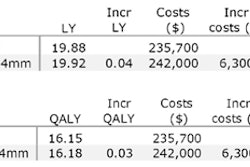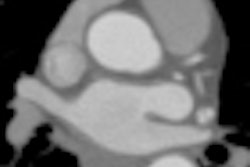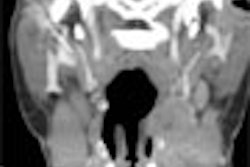Nearly one-fifth of patients undergoing coronary artery bypass graft surgery (CABG) had potentially serious incidental findings at CT coronary angiography (CTA) performed after the procedure.
CTA found a number of occult and potentially life-threatening conditions in time to treat them, according to a study of nearly 300 patients by researchers from the University of Maryland School of Medicine in Baltimore, and Allegheny General Hospital in Pittsburgh.
"Coronary CT angiography examinations are typically acquired with a small field of view focused on the heart, but portions of the lungs, pleura, chest wall, mediastinum, thoracic skeleton, and upper abdomen are often included as part of the examination," wrote Dr. Jeffrey Mueller et al. "Although a wider field of view may be reconstructed from the raw data to assess for additional thoracic findings, these images are not typically used to evaluate the coronary arteries and bypass grafts" (American Journal of Roentgenology, Vol. 189:2, pp. 414-419).
Significant incidental findings requiring intervention or further radiologic evaluation have been documented in electron beam CT (EBCT) studies. However, similar information about CTA is very limited, noted Muller and his co-authors Dr. Jean Jeudy, Dr. Robert Poston, and Dr. Charles White. And because CTA, unlike EBCT, uses thinner slices and contrast enhancement, its potential benefits in uncovering occult disease are possibly even greater, they stated.
"Our study of a rather large cohort of patients suggests a frequency of unsuspected and potentially significant findings of approximately20% in patients who undergo cardiac CTA both immediately and remotely after CABG," they wrote.
In the study, CTA was performed postoperatively in259 patients, and a mean of 12.7 months after surgery in 40 patients who had follow-up CTA. After the CABG intervention (mean, 5.2 days postoperatively) 259 patients (mean age, 63.7years; age range, 37-89 years; 73.4% men, 26.6% women) underwent routine contrast-enhanced cardiac CTA, the authors reported.
Cardiac CTA data were acquired using a 16-slice CT scanner (MX8000IDT, Philips Medical Systems, Andover, MA), ECG gating and bolus timing, with a small 250-mm field of view (matrix 512 x512) centered on the heart, the study reported.
Following IV administration of iodinated contrast material (120-150 mL) at 3-4 mL/s, CT images were acquired at 140 kVp and 350-500 mAs. Beta blockade was typically provided as part of routine postoperative care, and for imaging, patients had to be in sinus rhythm with a mean heart rate less than 100 beats per minute, the group wrote.
Phases obtained at 75% of the R-R interval were reconstructed and used for primary analysis by two thoracic radiologists, who evaluated the medical record, evaluated the images for the presence of graft disease and incidental findings, and reported the findings in consensus.
"A finding was judged potentially significant if a therapeutic intervention or radiologic follow-up was deemed advisable on the basis of the cardiac CTA," the authors wrote. "Bypass graft occlusions were analyzed separately."
Among the patients imaged postoperatively, 51 (19.7%) had at least one unsuspected, potentially significant finding, the group reported. There were 24 patients (9.3%) with cardiac findings such as ventricular pseudoaneurysm, ventricular perfusion deficit, or intracardiac thrombus, and 34 patients (13.1%) with noncardiac findings that included pulmonary embolism, lung cancer, or pneumonia.
"The most common cardiac findings were a moderate or large pericardial effusion (eight patients, 3.1%), intracardiac thrombus (six patients, 2.3%), and substantial paracardiac or mediastinal hemorrhage (six patients, 2.3%)," they wrote. "Among noncardiac abnormalities, pulmonary nodule (nine patients, 3.5%), pneumonia (six patients, 2.3%), tracheal or lobar mucous plugging (six patients, 2.3%), and pulmonary embolism (five patients, 1.9%) were most frequent."
Based on the CT results, 15 patients (5.8%) underwent clinical intervention and 12 patients (4.6%) had follow-up imaging, while two patients had both. Twenty-six patients (10%) were lost to follow-up or had no further intervention documented.
"Further interventions included repeat cardiac surgery (three patients, 1.2%), hospital readmission (one patient, 0.4%),insertion of a pericardial drainage catheter (one patient, 0.4%),lung carcinoma (one patient, 0.4%), anticoagulation (five patients,1.9%), bronchoscopy for a large mucous plug (one patient, 0.4%),blood transfusion (two patients, 0.8%), and antibiotic treatment for pneumonia (three patients, 1.2%).
Studies using MDCT and intravenous contrast have yielded higher numbers of patients with significant findings, the authors noted. Shafiqueet al and Onuma et al each found significant noncardiac findings requiring further investigation or treatment on contrast-enhanced cardiac CTA examinations of 16%. Haller et al also showed a high prevalence (44%) of significant or potentially significant noncoronary disease.
The authors found the prevalence of noncardiac findings similar to those reported in two abstracts, by Shafique et al and Onuma et al (16% in both). And last year, Haller and colleagues found that 4.8% of patients undergoing cardiac CTA with a small field of view had a major noncardiac finding, while 19.9% had a minor noncardiac finding (AJR, July 2006, Vol. 187:1, pp. 105-110.)
"However,the rate of incidental cardiac findings in this study was much higher," the authors of the current study reported. "Nearly every coronary bypass patient has known ischemic heart disease. Therefore, the discovery of complicating conditions,such as intracardiac thrombi, myocardial perfusion deficits,and ventricular aneurysms from significant coronary arterydisease is not surprising. In addition, large mediastinal or paracardiac hemorrhage was included in the cardiac category, another condition that occasionally occurs after coronary bypass."
Certainly the results suggest that incidental disease at cardiac CTA is found more frequently after major cardiovascular surgery, such as CABG, than in typical outpatients CTA exams, they noted. The results also highlight the need to examine noncardiac anatomy on every CTA exam, inasmuch as many treatable and clinically unsuspected conditions can be found.
In any case, bypass graft patency is a common indication for cardiac CTA, they noted, particularly among patients with recurrent symptoms after CABG. In the study, at least one failed graft occurred in 6.6% of patients postoperatively, and in 10% of patients in the later follow-up.
"Cardiac CTA after CABG revealed a high prevalence of unsuspected cardiac and noncardiac findings with potential clinical significance," the authors concluded. "Interpreters of these studies should be familiar with the spectrum of these abnormalities."
By Eric Barnes
AuntMinnie.com staff writer
August 6, 2007
Related Reading
JAMA study: Coronary CTA poses substantial cancer risk in select patients, July 17, 2007
Triple-rule-out CT yields even contrast enhancement, January 22, 2007
Cardiac CT yields significant extracardiac findings, November 26, 2006
Cardiac CT evolves on multiple fronts, November 20, 2006
Copyright © 2007 AuntMinnie.com



















